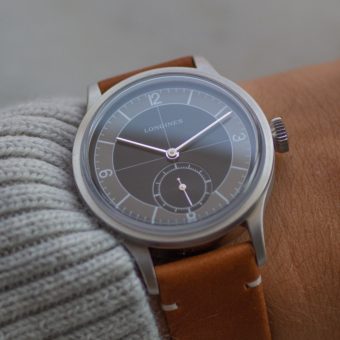Monopusher chronographs honor the origins of the stopwatch function with looks that often cite their own history – a good fit for the current vintage-look trend. The bicompax displays on our test pieces — from Hanhart, Longines, and Montblanc — underscore the linear nature of the stopwatch function. See how they stack up against each other in this feature from our archives, with original photos by Olaf Köster.
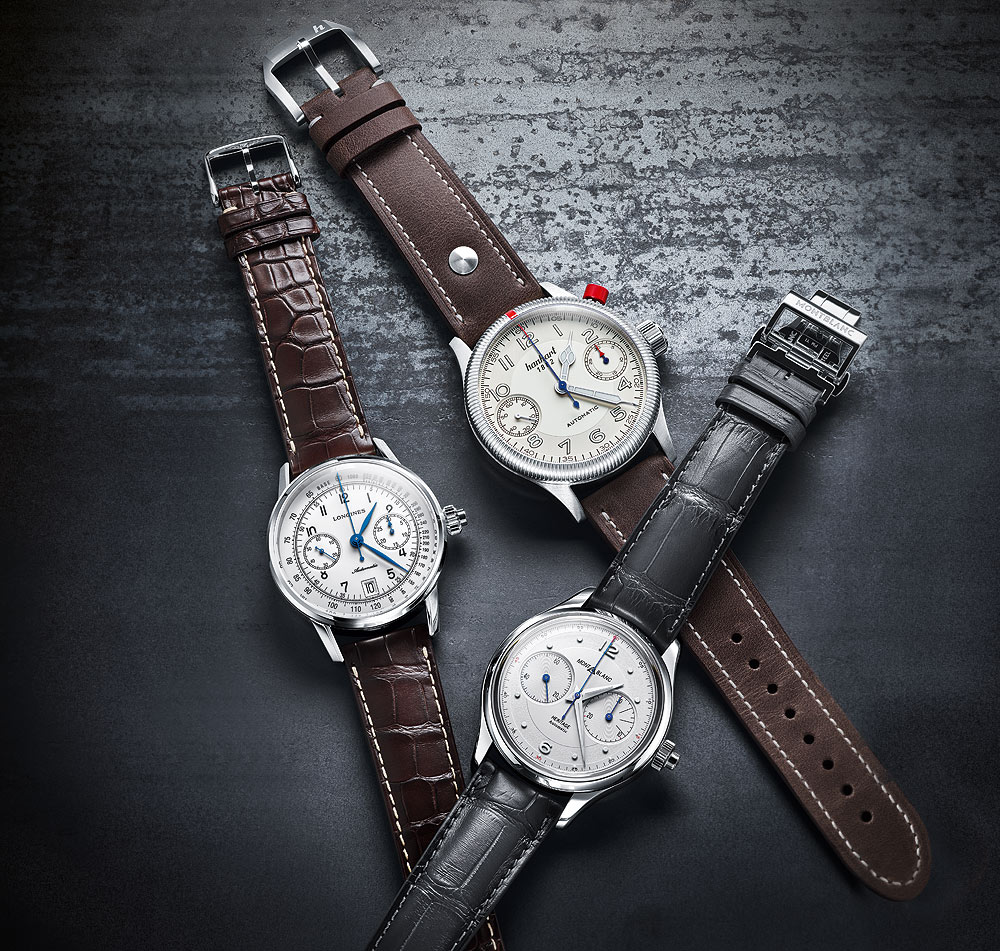
Monopusher chronographs with bicompax displays are reaching deep into the past in two ways. By the mid-1930s, developments from Breitling first resulted in a second chronograph pusher that made it possible to stop and restart the recording of time intervals multiple times. Previously only a single linear measurement was possible with a single push-button – to start, stop, reset – just like our three current test watches from Hanhart, Longines and Montblanc. Each of these stopwatches continues to write its own personal history.
The return of the monopusher chronograph follows the same trend of linearity and clarity as the bicompax display, giving us a better overview of the chronograph dial.
One Pusher, Two Subdials
Bicompax is the designation for a dial with only two subdials – one register for the small seconds, usually at the 9 o’clock position, and one for the timed minutes, usually at 3 o’clock. This type of display has been around since the early 20th century and is currently seeing a rebound in popularity. Hanhart, Longines and Montblanc are following this ongoing trend and find inspiration in their own history books.
In the first half of the last century, Hanhart carried out groundbreaking work in the development of functional stopwatches. In 1938, the company built a monopusher chronograph for marine officers with its own Caliber 40 movement. The resurgence of the single pusher is also the characteristic feature of the modern Pioneer MonoScope, currently with a movement based on the ETA Valjoux 7750. The lever, which normally sits under the reset pusher at 4 o’clock, has no function. The reset is activated using the main operating lever and a modified cam. It has an additional notch so the main operating lever can control three positions.
The Red Hanhart Pusher
But that’s not all. The uncommon position of the single chronograph pusher is a specialty of the house. For this, Hanhart integrates its own in-house development: a transfer lever to relay power over the additional millimeters of the large 45-mm stainless-steel case. The distinctive red pusher has been a Hanhart trademark since 1939 and is designed to prevent the unintentional stopping of the chronograph.
Another unique feature of the Pioneer MonoScope is the placement of the subdials for the small seconds at 9 o’clock and for the 30-minute counter at 3 o’clock. Shifting them outward almost to the edge of the dial also required a modification. The centers of rotation of the two small hands form a vertical line with the numerals 2/4 and 8/10 so that the display corresponds exactly with the 1930s’ design with the Caliber 40. The overall instrument-like feel of the light beige dial is enhanced with clearly executed tracks, downward curved tips on the skeletonized hands and brightly glowing numerals.
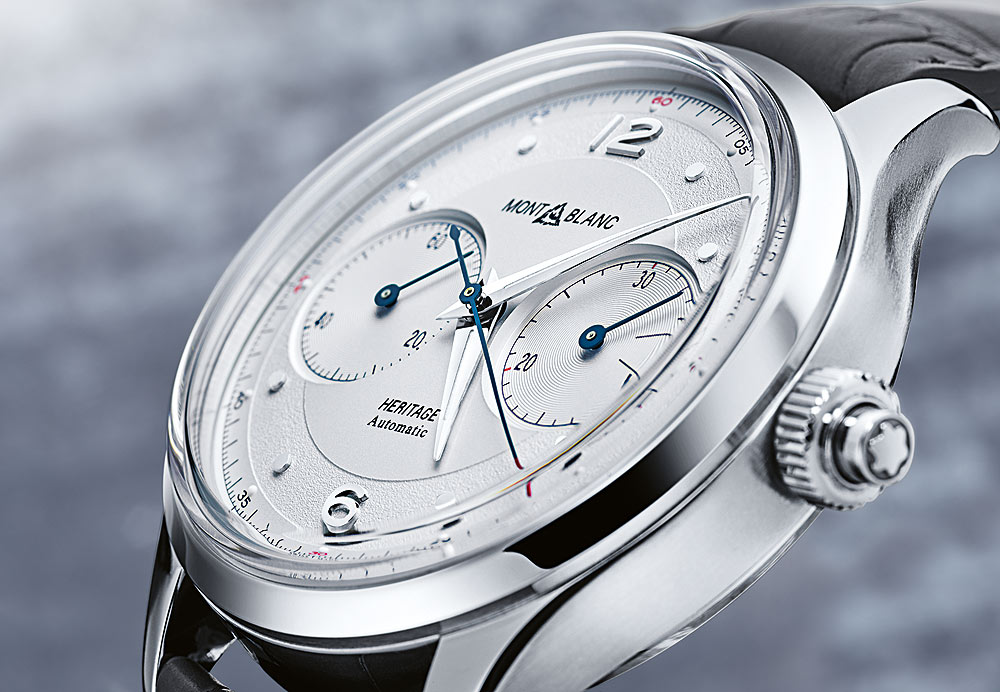
The Minerva Touch at Montblanc
Minerva watches in the 1940s and ’50s had a very similar quality and serve as the inspiration for the brand-new Montblanc Heritage Monopusher Chronograph. The connection first began with the purchase of Minerva in 2006 by the Richemont group whereby the manufacture became the movement supplier to Montblanc. But there is no Minerva-based caliber in the 42-mm stainless-steel case of our test watch; it is equipped with a modified Sellita SW510 movement, which keeps this monopusher chronograph in the affordable mid-range in price.
Similar to the Hanhart, the cam system was changed for the modification. And like most manufacturers who offer monopusher chronographs (but unlike the Hanhart), its pusher is integrated in the crown. The 12-hour counter and date indication have also been eliminated.
Heritage Watches in Line with History
The silvery-white Montblanc dial – with its curved edge, applied numerals and dot markers, extremely fine tracks and dauphine hands – recalls the look of vintage Minerva timepieces.
Small details like the extended marker lines at 3, 6 and 9 on the chrono minutes counter, which in the past served as way to track charges when using coin-operated telephones, deepen the vintage character of the Montblanc Heritage Monopusher Chronograph. Montblanc underscores this look with its historical logo in the same place the Minerva name once stood. (A very similar Minerva watch bore the Heritage name in the 1990s.)
Longines also continues to cultivate a Heritage line of its own, re-issuing new versions of legendary models. The Column-Wheel Single Push-Piece Chronograph can be traced to the first half of the 20th century. Even its movement is based on the first movement Longines created for wristwatches in 1913, the Caliber 13.33Z.
Combined Vintage and Modern Movement For Longines
Longines, a member of the Swatch Group, commissioned the movement manufacturer ETA to develop an exclusive chronograph movement with self-winding mechanism and column-wheel control, later known as the L688.2. The 2010 movement A08L.11 was followed two years later by the L788.2 with chronograph control via an integrated pusher in the crown. This, in combination with a column wheel, is rather rare these days, especially at the price of this Longines. The newly designed, absolutely symmetrical column wheel from ETA made of blued stainless steel provides ease and convenience and an attractive layout of the mechanism that is visible through a sapphire crystal caseback – something that only Longines, of these three, offers.
But the solid caseback of the Montblanc Heritage Monopusher Chronograph is also worth a close look. It shows a relief image of the Minerva production facility, which is now the Montblanc Manufacture Villeret. In addition to various specifications like water resistance to 50 meters, the special Montblanc Laboratory Test of 500 hours is cited, which every model in the Heritage product line must undergo.
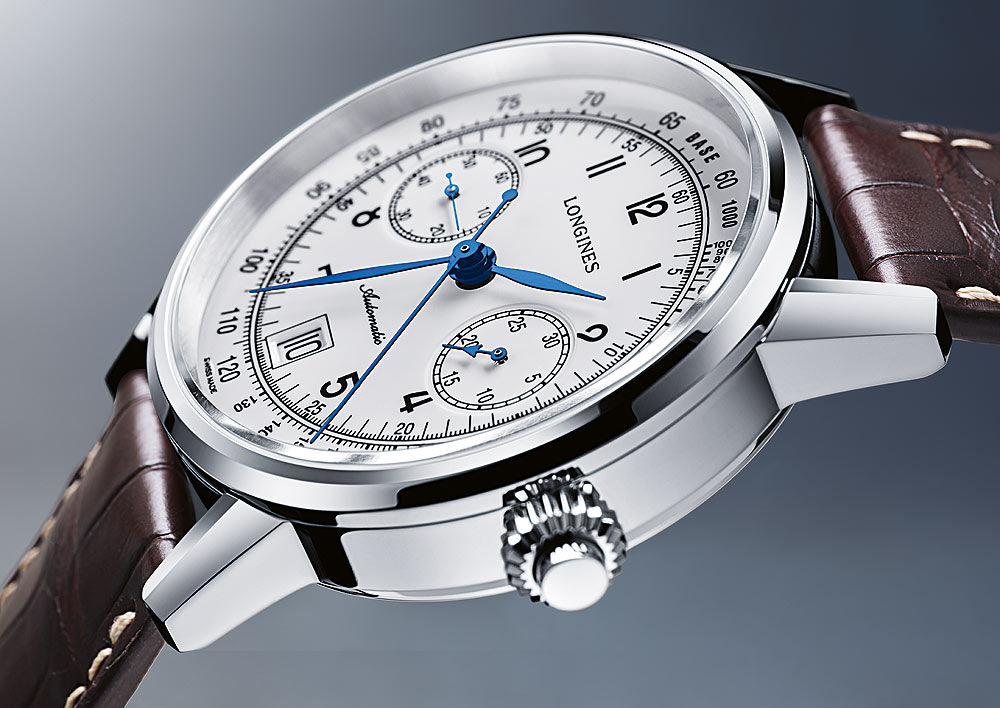
The case finishes up top with with a box-shape sapphire crystal that nicely enhances the vintage look. Sharply downward sloping lugs ensure comfort, along with a high-grade Sfumato alligator strap from the Pelletteria Richemont in Florence. This ensemble is completed with a double folding clasp; Montblanc is the only one of this trio to offer one.
Authentic Domed Crystals, Fine Tracks, Delicate Hands
Operation of the chronograph is controlled by the integrated pusher in the crown. It has solid pressure points though its action is still not quite as smooth as the column-wheel control in the Longines Heritage Column-Wheel Single Push-Piece Chronograph. At the start a blued seconds hand points to the tachymeter track on the dial’s edge.
The fine inner stopwatch seconds track has an instrument-like look. Unfortunately its four incremental line markers do not fully correspond to the 4-Hz rhythm of Caliber L788.2. Both Hanhart and Montblanc have a more accurate presentation of the stopwatch seconds track and their hands point precisely to track markings with their red and curved tips, respectively, and as they pass the 0 point, the minute counter hands jump slightly as they advance one position. The minutes counter hand of the Longines chronograph has a fluid movement.
In addition to the nicely sized date display (that only the Longines chronograph offers) this is a considerable difference in the chronograph mechanism. The Longines chronograph also comes on an alligator strap and pin buckle.
Price Difference
Befitting its size, Hanhart provides a sturdy calfskin strap and pin buckle, ensuring that the opulent timepiece sits perfectly on the wrist. Its grooved crown is large and easy to grasp and operate, as is the exposed pusher. Not least, with the fluted bidirectional rotating bezel including its signature red orientation mark, the Pioneer MonoScope Chronograph authentically follows its legendary predecessor and is, at $3,130, a fair price for fans of vintage watches and the Hanhart brand.
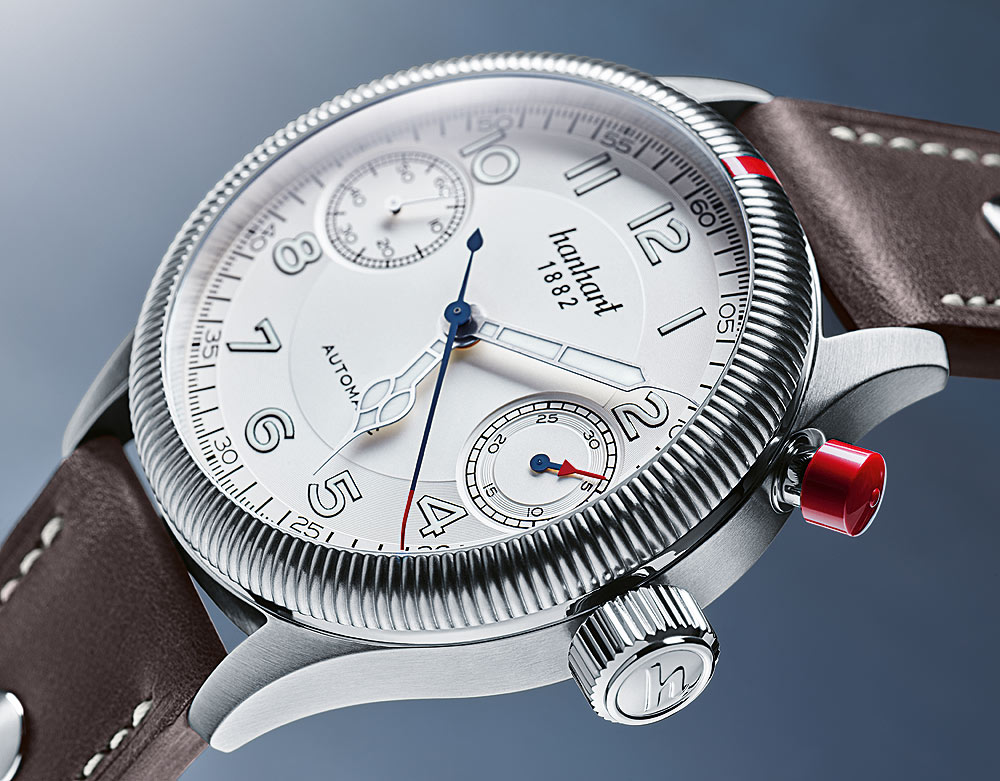
The Longines Heritage Column-Wheel Single Push-Piece Chronograph is hard to beat at a price of $3,150. It offers a modern and exclusive caliber inside a historically accurate outfit. The Heritage Monopusher Chronograph from Montblanc combines two stories in one timepiece, but this does not justify its much higher price compared to the Hanhart and the Longines.
SPECS:
Hanhart Pioneer MonoScope
Manufacturer: Hanhart AG
Reference number: 733 220-011
Functions: Hours, minutes, small seconds, chronograph, (center elapsed seconds, 30-minute counter), bidirectional rotating bezel with marker
Movement: HAN4212, bicompax, based on ETA Valjoux 7750, automatic, 28,800 vph, 31 jewels, nickel gold-plated balance, Nivarox hairspring, Incabloc shock absorber, pointer (two-part) fine regulator, 42-hour power reserve, diameter = 30.0 mm, height = 7.90 mm
Case: Stainless steel, domed sapphire crystal with antiglare coating on both sides, water resistant to 100 m
Strap and clasp: Calfskin with rivets, pin buckle
Rate results (Deviation in seconds per 24 hours):
On the wrist +1.2
Fully wound +1.2
Fully wound (chrono) +0.5
After 24 hours +1.7
Dimensions: Diameter = 45.43 mm, height = 15.81 mm, weight = 138.0 g
Variations: With black dial and leather strap, with stainless-steel bracelet, with smooth bezel
Price: $3,130
SPECS:
Longines Heritage Column-Wheel Single Push-Piece Chronograph
Manufacturer: Longines Watch Co. Francillon Ltd., Les Longines, 2610 Saint-Imier, Switzerland
Reference number: L2.800.4.23.2
Functions: Hours, minutes, small seconds, chronograph, (center elapsed seconds, 30-minute counter), tachymeter track, date
Movement: Caliber L788.2 based on ETA A08.L11, automatic, 28,800 vph, 27 jewels, nickel gold-plated balance, Nivarox hairspring, Nivachoc shock absorber, pointer (two-part) fine regulator, 54-hour power reserve, diameter = 30.0 mm, height = 7.90 mm
Case: Stainless steel, domed sapphire crystal with antiglare treatment above dial, sapphire crystal back, water resistant to 30 m
Strap and clasp: Alligator with pin buckle
Rate results (Deviation in seconds per 24 hours):
On the wrist +3.2
Fully wound +3.3
Fully wound (chrono) +3.8
After 24 hours +2.9
Dimensions: Diameter = 41.05 mm, height = 14.04 mm, weight = 90.0 g
Variations: Black dial and alligator strap
Price: $3,150
SPECS:
Montblanc Heritage Monopusher Chronograph
Manufacturer: Montblanc, Chemin des Tourelles 10, 2400 Le Locle, Switzerland
Reference number: 119951
Functions: Hours, minutes, small seconds, chonograph (central elapsed- seconds hand, 30-minute counter)
Movement: MB 25.12 based on Sellita SW510, automatic, 28,800 vph, 27 jewels, gold-plated nickel balance, Nivarox hairspring, pointer (two-part) fine adjustment, Incabloc shock absorber, 48-hour power reserve, diameter = 30.0 mm, height = 7.90 mm
Case: White gold, box-type sapphire crystal anti-reflectively treated on top, water resistant to 50 m
Strap and clasp: Sfumato alligator with double folding clasp with push buttons
Rate results (Deviation in seconds per 24 hours):
On the wrist +1.0
Fully wound +2.8
Fully wound (chrono) +1.7
After 24 hours +1.4
Dimensions: Diameter = 41.90 mm, height = 14.82 mm, weight = 112.0 g
Variations: With various dial colors; with Milanese mesh bracelet ($5,160)
Price: $4,950


